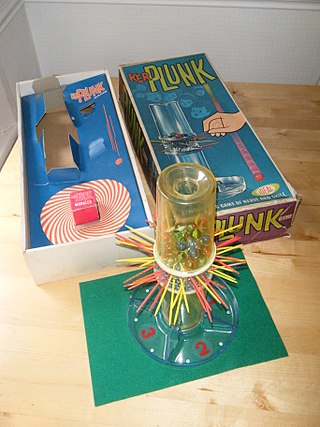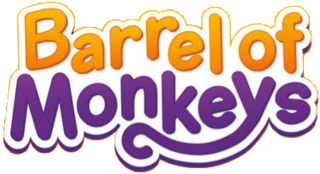
Hasbro, Inc. is an American multinational conglomerate holding company incorporated and headquartered in Pawtucket, Rhode Island. Hasbro owns the trademarks and products of Kenner, Milton Bradley, Parker Brothers, and Wizards of the Coast, among others. As of August 2020, over 81.5% of its shares were held by large financial institutions.

Milton Bradley Company or simply Milton Bradley (MB) was an American board game manufacturer established by Milton Bradley (1836-1911) in Springfield, Massachusetts, in 1860. In 1920, it absorbed the game production of McLoughlin Brothers, formerly the largest game manufacturer in the United States. It was acquired by Hasbro in 1984, and merged with their subsidiary Parker Brothers in 1998. The brand name continued to be used by Hasbro until 2009.

Jenga is a game of physical skill created by British board game designer and author Leslie Scott and marketed by Hasbro. Players take turns removing one block at a time from a tower constructed of 54 blocks. Each block removed is then placed on top of the tower, creating a progressively more unstable structure.

Candy Land is a simple racing board game created by Eleanor Abbott and published by Milton Bradley in 1948. The game requires no reading and minimal counting skills, making it suitable for young children. No strategy is involved as players are never required to make choices; only following directions is required. About one million copies per year are sold.

Parker Brothers was an American toy and game manufacturer which in 1991 became a brand of Hasbro. More than 1,800 games were published under the Parker Brothers name since 1883. Among its products were Monopoly, Clue, Sorry!, Risk, Trivial Pursuit, Ouija, Aggravation, Bop It, Scrabble, and Probe. The trade name became defunct with former products being marketed under the "Hasbro Gaming" label with the logo shown on Monopoly games.

Battleship is a strategy type guessing game for two players. It is played on ruled grids on which each player's fleet of warships are marked. The locations of the fleets are concealed from the other player. Players alternate turns calling "shots" at the other player's ships, and the objective of the game is to destroy the opposing player's fleet.

Connect Four is a game in which the players choose a color and then take turns dropping colored tokens into a six-row, seven-column vertically suspended grid. The pieces fall straight down, occupying the lowest available space within the column. The objective of the game is to be the first to form a horizontal, vertical, or diagonal line of four of one's own tokens. It is therefore a type of M,n,k-game with restricted piece placement. Connect Four is a solved game. The first player can always win by playing the right moves.

Yahtzee is a dice game made by Milton Bradley. It was first marketed under the name of Yahtzee by game entrepreneur Edwin S. Lowe in 1956. The game is a development of earlier dice games such as Poker Dice, Yacht and Generala. It is also similar to Yatzy, which is popular in Scandinavia.

Simon is an electronic game of short-term memory skill invented by Ralph H. Baer and Howard J. Morrison, working for toy design firm Marvin Glass and Associates, with software programming by Lenny Cope. The device creates a series of tones and lights and requires a user to repeat the sequence. If the user succeeds, the series becomes progressively longer and more complex. Once the user fails or the time limit runs out, the game is over. The original version was manufactured and distributed by Milton Bradley and later by Hasbro after it took over Milton Bradley. Much of the assembly language code was written by Charles Kapps, who taught computer science at Temple University and also wrote one of the first books on the theory of computer programming. Simon was launched in 1978 at Studio 54 in New York City and was an immediate success, becoming a pop culture symbol of the 1970s and 1980s.
Reynolds Winsor "Reyn" Guyer is an American inventor.

Nerf is a toy brand formed by Parker Brothers and currently owned by Hasbro. Most of the toys are a variety of foam-based weaponry, with other Nerf products including balls for sports such as American football, basketball, and baseball. Their best known toys are their dart guns that shoot ammunition made from "Nerf foam". Their primary slogan, introduced in the 1990s, is "It's Nerf or Nothin'!". Annual revenues under the Nerf brand are approximately US$400 million.

McLoughlin Bros., Inc. was a New York manufacturing company active between 1858 and 1920. As a publisher itself, the company was a pioneer in color printing technologies in children's books. The company specialized in retellings or bowdlerizations of classic stories for children.

KerPlunk is a children's game invented by Eddy Goldfarb with Rene Soriano and first marketed by the Ideal Toy Company in 1967. The game consists of a transparent plastic tube, plastic rods called straws and several dozen marbles. The base contains four separate numbered trays; the straws are passed through holes in the middle of the tube to form a lattice. The marbles are then placed in the top of the tube and held in place by the lattice. The onomatopoeic name of the game derives from the sound of the marbles tumbling to the base of the tube during play.

Playskool is an American brand of educational toys and games for children. The former Playskool manufacturing company was a subsidiary of the Milton Bradley Company and was headquartered in Pawtucket, Rhode Island. Playskool's last remaining plant in Chicago was shut down in 1984, and Playskool became a brand of Hasbro, which had acquired Milton Bradley that same year.

Barrel of Monkeys is a toy game released by Lakeside Toys in 1965. It was created by Leonard Marks and Milton Dinhofer in 1961, and in 1964, Herman Kesler partnered to sell it to Lakeside Toys, which released it in 1965. It was then produced by the Milton Bradley Company, and Hasbro. Milton Bradley's editions consisted of a toy barrel in either blue, yellow, red, purple, orange, gray or green. The barrel contains 13 monkeys but can hold 24, their color usually corresponding to the barrel's color. The instructions state, "Dump monkeys onto table. Pick up one monkey by an arm. Hook other arm through a second monkey's arm. Continue making a chain. Your turn is over when a monkey is dropped." In addition to these basic instructions, the barrel also contains instructions for playing alone or with two or more players.
Charles Foley was the co-inventor of the game Twister, with Neil W. Rabens.

Milton Bradley was an American business magnate, game pioneer and publisher, credited by many with launching the board game industry, with his eponymous enterprise, which was purchased by Hasbro in 1984, and folded in 1998.

Schaper Toys, or W.H. Schaper Mfg. Co., Inc. as it was originally known, was a game and toy company founded in 1949 by William Herbert Schaper in Robbinsdale, Minnesota. "Herb" Schaper published a variety of games but was best known for having created the children's game, Cootie. In 1971, the company was sold to Kusan, Inc., and began operating as Schaper Toys, a subsidiary of Kusan, Inc. In 1986, Schaper Toys was acquired by Tyco Toys, which sold the rights to Cootie and three other of the company's best-known games to the Milton Bradley Company. These games are still being sold.

The Game of Life, also known simply as Life, is a board game originally created in 1860 by Milton Bradley as The Checkered Game for Life, the first ever board game for his own company, the Milton Bradley Company. The Game of Life was US's first popular parlour game. The game simulates a person's travels through their life, from early adulthood to retirement, with college if necessary, jobs, marriage, and possible children along the way. Up to six players, depending on the version, can participate in a single game. Variations of the game accommodate up to ten players.





















